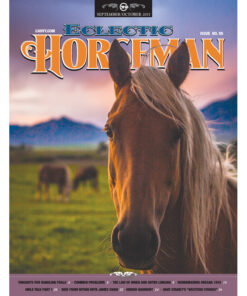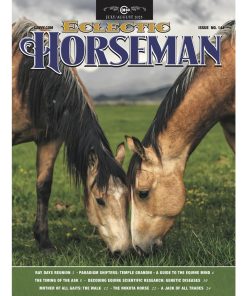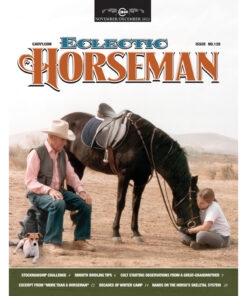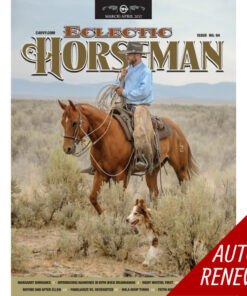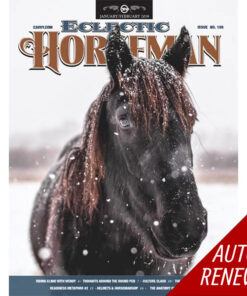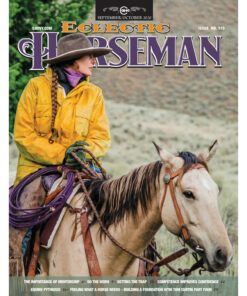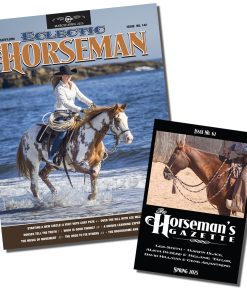Eclectic Horseman Issue No. 145
September/October 2025 – Subscribe Today!
Rest in Peace Larry Fleming
Obituary for Larry Fleming, a respected horseman who grew up riding and roping on the ranches of Montana and South Dakota. After establishing Larry Fleming Equine Services in Colorado, he became known for starting and training hundreds of horses across disciplines, always striving to help owners understand their horses better.
Choice not Chaos: Dancing with Ray Hunt by Barney Nelson, Ph.D.
Drawing from a reprinted 1985 article, this piece revisits the horsemanship teachings of Ray Hunt, emphasizing that the keys to connection—like “feel,” “timing,” and “balance”—are not elementary, but foundational. The core of Hunt’s philosophy is “making the wrong thing difficult and the right thing easy,” allowing the horse to choose the correct response, leading to a profound partnership that feels like “dancing.”
The Profile Eclectic – Jec Aristotle Ballou – Equine Conditioning Expert By Katrina Hays
This profile introduces Jec Aristotle Ballou, an expert in equine conditioning who advocates for making every horse an athlete before pursuing specific riding goals. Citing the rigorous preparation of human athletes like ballerinas and football players, Ballou emphasizes that proper strength, balance, and fitness are essential to keeping horses sound and willing in their work.
The Good Old Days by Katrin Silva
Despite online complaints that modern horsemanship is in decline due to readily available misinformation, this article argues that the “good old days” were less accessible and that the present era offers new advantages. Today, the luxury of viewing the horse as a partner, combined with the power of scientific discovery, allows for a more nuanced, compassionate, and expansive evolution of our equestrian traditions.
Three Simple Moves That Will Help Your Horse to Understand You By Dave Ellis
Through observation of top clinicians, the author has identified three fundamental moves that lead to successful horsemanship across all styles. These simple—but not easy—moves are rewarding with release, applying steady pressure, and supporting that steady request with timely rhythmic pressure to offer the horse more information.
Reflecting On The Horse By Sonia M. Kudalsky
True partnership in horsemanship requires the human to observe and listen to the horse’s body language, moving beyond dictation to mutual communication. By emphasizing clarity and consistency, and by making the correct response the path of least resistance, a relationship built on trust and the horse’s natural willingness is formed.
Riding from the Seat By Jan Young
Initially focused on her legs, the author’s horsemanship journey took a transformative turn after observing her late husband, Jack Young, who rode almost entirely from his body and hips. By redirecting her attention from the legs to the subtle movements of her seat bones and the engagement of the upper inner thigh (adductors), she learned to ride with greater subtlety and allow her horse to follow her feel.
The Art of Being an Excellent Student By Amy Skinner
Becoming an excellent student is a skill set that must be learned, requiring more than simply showing up and spending money. The path to mastery involves internal work, specifically accepting that the struggle is part of the process, quieting the mind to truly listen, and developing a tolerance for not knowing all the answers immediately.
The Angry Circle By Tom Moates
After witnessing horsemen angrily driving their horses in a warm-up circle, the author questions why so many people use unnecessary pressure and hostility in their training. This reflection explores the various causes of anger in horsemanship, concluding that such ire often stems from a lack of empathy for the horse’s instinctual nature and a focus on self-serving competitive goals rather than partnership.
Mecate Lore By Steve Harris
This article celebrates the traditional vaquero gear of the horsehair mecate, detailing its construction and significant role in effective hackamore horsemanship. The unique stiffness and “life” of a tightly-twisted mecate aid the rider in delivering subtle, coherent, and consistent cues, which is crucial for teaching a horse to neck-rein out of willingness and association.
Handing Over the Reins-There are pros and cons to inviting someone else to ride your horse…By Lee McLean
While some view inviting another person to ride their horse with horror, this practice offers both risks and valuable rewards for the horse’s training. Handing over the reins, especially to a knowledgeable rider, provides constructive, objective feedback that exposes any holes in the horse’s understanding and prevents the creation of a “one-man horse.”

